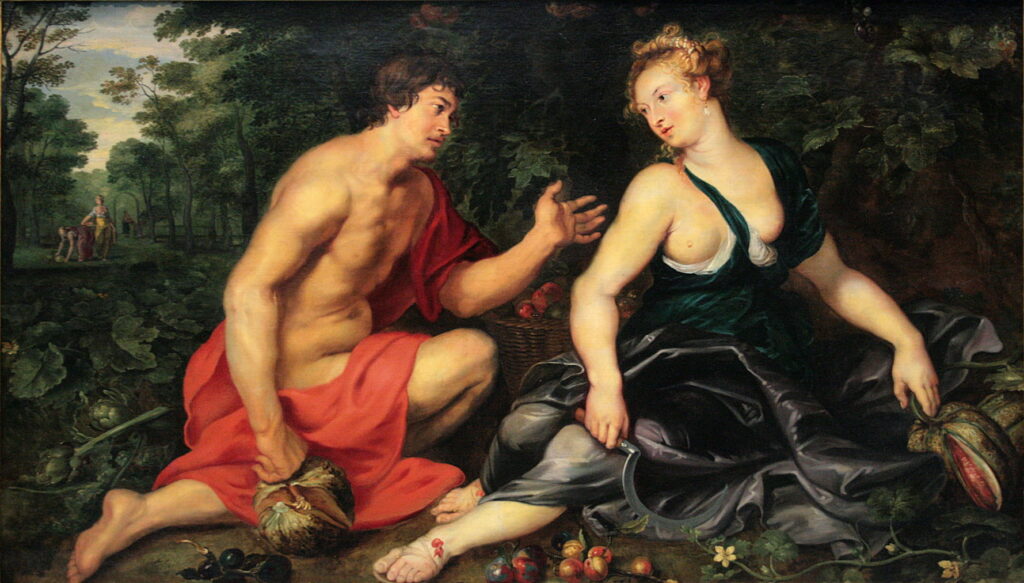Painting the gardener 1 to 1700

We’re not travelling far for this weekend’s paintings, just out to the backyard to meet the gardeners who tend the flowers and care for the cabbage patch. Although gardens have long been owned by the rich, as part of their estate, on a smaller scale cottage gardens have supplemented the family’s diet, and most recently a well-tended garden has become a suburban status symbol.
In the seventeenth century the most popular tale about a gardener was the myth about Vertumnus and Pomona. The latter was an enthusiastic gardener, who was seduced by Vertumnus, god of the seasons, gardens and plant growth. At first the god tried disguising himself as an old woman, without success, and it was only when he resumed his normal form as a young man that Pomona fell for him.
Hendrik Goltzius (1558–1617), Vertumnus and Pomona (1613), oil on canvas, 90 x 149.5 cm, Rijksmuseum Amsterdam, Amsterdam, The Netherlands. Wikimedia Commons.
Hendrik Goltzius gets close up in his Vertumnus and Pomona from 1613, and arms Pomona with a vicious-looking pruning knife. There’s a wonderful contrast between the two women’s faces and hands here, making this a fine study of the effects of age.
Abraham Bloemaert (1564–1651), Vertumnus and Pomona (1620), oil on canvas, 98 x 125 cm, Private collection. Wikimedia Commons.
Abraham Bloemaert’s Vertumnus and Pomona (1620) uses gaze to great effect: while the persuasive Vertumnus looks up at Pomona, her eyes are cast down, their lids nearly closed.
Anthony van Dyck (1599–1641) and Jan Roos (c 1591–1638), Vertumnus and Pomona (c 1625), oil, 142 x 197 cm, Musei di Strada Nuova, Genoa, Italy. Wikimedia Commons.
Anthony van Dyck and Jan Roos collaborated in painting Vertumnus and Pomona in about 1625, which is remarkable for its rich symbolism and visual devices. Pomona has her left arm around Vertumnus, but in her right hand holds a silver sickle. She gazes wistfully into the distance, as if in a dream. Vertumnus is again looking up, pleading his case with the young woman, and his left hand (on a very muscular and masculine arm) is behind Pomona’s left knee, between her legs. At the right, Cupid grimaces at the deception, his back turned, pointing at what is going on with apparent disapproval.
Adriaen van de Velde (1636–1672), Vertumnus and Pomona (1670), oil, 76.5 x 103 cm, Kunsthistorisches Museum, Vienna. Wikimedia Commons.
Adriaen van de Velde’s fine Vertumnus and Pomona from 1670 has been marred by the fading of the yellow used to mix some of his greens, turning some of its foliage blue. He avoids any dangerous allusions, and returns to a more distant view of the pair talking together.
Peter Paul Rubens (1577–1640), Vertumnus and Pomona (1636), oil on panel, 26.5 × 38.3 cm, Museo Nacional del Prado, Madrid, Spain. Wikimedia Commons.
Peter Paul Rubens hints at the outcome in his late oil sketch of Vertumnus and Pomona of 1636. There’s now no pretence that Vertumnus is a woman: he lacks breasts, and even has heavy beard stubble. However, the embrace of his right arm still brings Pomona to push him away with her left arm.
Peter Paul Rubens (1577–1640), Vertumnus and Pomona (1617-19), oil on canvas, 120 x 200 cm, Private collection. Image by Jean-Pol GRANDMONT, via Wikimedia Commons.
In Rubens’ earlier and finished Vertumnus and Pomona from 1617-19, Vertumnus has assumed his real form, that of a handsome young man. Pomona looks back, her sickle still in her right hand, and her rejection of his advances is melting away in front of our eyes. Rubens even provides distant hints at Vertumnus doing the work in the garden while Pomona directs him, at the upper left.
Another well-known narrative featuring a gardener is the encounter between the resurrected Christ and Mary Magdalene, who sees him as a gardener in a scene known as Noli me tangere, from the Latin translation of the words that Christ is recorded as saying.
Jacopo di Cione (fl c 1365-1398/1400) (probably), Noli me tangere (1368-70), egg tempera on wood, 56 x 38.2 cm, The National Gallery (Presented by Henry Wagner, 1924), London. Courtesy of and © The National Gallery, London.
This painting of Noli me tangere from around 1368-70 has been attributed to Jacopo di Cione, and shows Mary Magdalene kneeling with her hands outstretched towards the resurrected Christ. He is carrying an adze, a reference to Mary’s initial confusion of him with a gardener.
Lavinia Fontana (1552–1614), Jesus Appears to Mary Magdalene (1581), oil on canvas, 80 x 65.5 cm, Galleria degli Uffizi, Florence. Wikimedia Commons.
In her Jesus Appears to Mary Magdalene from 1581, Lavinia Fontana re-locates the ‘noli me tangere’ encounter between Mary and Jesus, giving him the garb of a mediaeval Italian gardener.
By the seventeenth century, these stories had become less popular, but gardeners appeared to mark the season of Spring.
Pieter Brueghel the Younger (1564–1638), Spring (date not known), oil on panel, 43 x 59 cm, Muzeul Național de Artă al României, Bucharest, Romania. Wikimedia Commons.
In Pieter Brueghel the Younger’s undated version of Spring, gardeners are planting out a formal Italianate flower-garden, a sight probably inspired during the artist’s visit to Italy. It has been suggested that this composition is even more ingenious, in showing March in the foreground, April behind, and May at the furthest end of the garden.
Tomorrow we’ll travel forward to the nineteenth century, and gardens humble and lavish.



